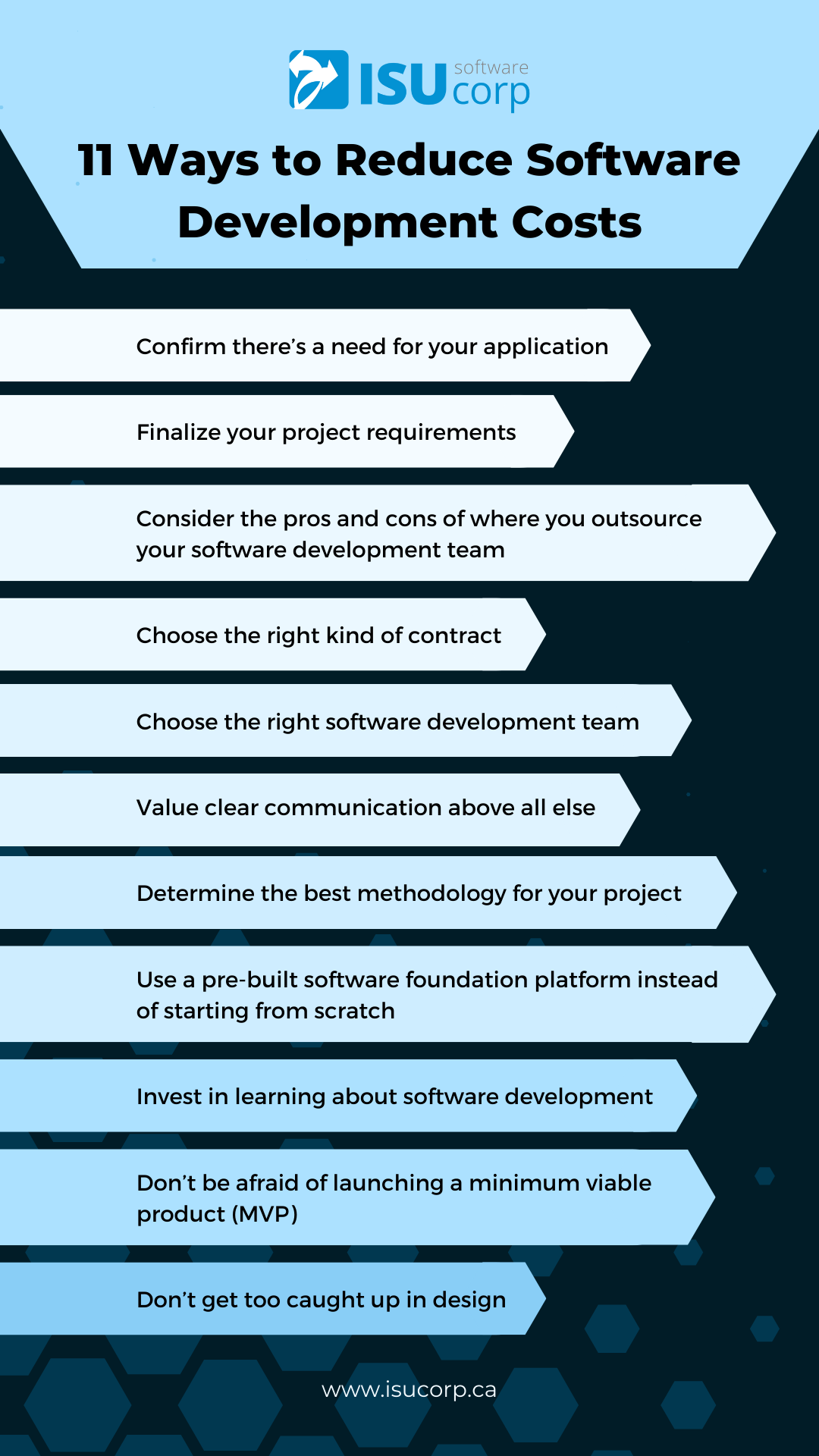Too often, a company will go into a software development project with a murky idea of what needs to be accomplished by the end of it. This can slow down communication on the requirements and ultimately delay the entire process. If developers don’t know what needs to be done, you’ll wind up paying for more of their time and adding up months or even years of extra work time.
While the cost of custom software development varies from project to project, there are 11 ways to minimize the risk of additional costs.
1. Confirm there’s a need for your application
While it may be tempting to jump head-first into what feels like a revolutionary app idea, resist the urge to invest your money in a project until you’ve done some preliminary research.
As someone creating a tool, it’s imperative that you think backwards from the user end of your solution. Think thoroughly about the issues and obstacles facing the people who will ultimately be using your completed software application. Make a comprehensive list of things to consider and determine if the market truly does need your application.
No one wants to invest thousands of dollars in something only to find out that no one really has any use for it. This is why a market study could save you (and make you) a lot of money. Completing thorough research on your target audience can not only show you that there’s a need for your project, but it could also help you identify key elements that should be included in your product. It’s always a better idea to start with the end in mind.
2. Finalize your project requirements
Now that you’ve determined there is a need for your application, you should have enough information to form a fleshed-out plan for your project. Being as clear and specific as possible on your requirements will give your software project a massive boost. With clear requirements, the right IT team can make your idea shine in less time and with fewer complications. The simpler the process becomes, the more money you save on your project. Plus, it saves developers the headache of guessing what it is you need.
If you bring a clear plan to the table, your software development team will also be more inclined to go above and beyond since you’ve removed unnecessary complications from the get-go.
3. Consider the pros and cons of where you outsource your software development team
There are a few ways to get a software application made, but the most popular way among companies is to outsource—you can read why this is the best option here.
When outsourcing, a vital factor is the location of the company you choose. Offshore outsourcing is when you hire a company abroad, often reducing the cost of hired work. However, doing so can also reduce the quality of the work you receive. The phrase, “You get what you pay for” always holds true. You may get cheaper labour, but due to time differences and communication barriers, the product may suffer as a result. These complications can also delay fixes that would otherwise be solved sooner with nearshore companies.
Nearshore outsourcing is when you hire from neighbouring countries. This can be more expensive, but it can also increase the likelihood of success for your end-product thanks to sharing a time zone and language. A mistake that’s been made can be fixed within the day rather than having to wait in eight-hour shifts to get it resolved.
The trick here is to determine the flexibility of your budget and time investment and find a company that can give you a high-quality project for a minimal cost.
4. Choose the right kind of contract
The first step is so critical to the success of your project that it will make a difference even in choosing a contract style with a third-party development team. How complex is your project? How many people will it take to build? How many additional changes or features are you factoring in?
If your idea is small in scale and fairly simple, you’re safe opting for a fixed-price contract. This is when you agree to pay a certain price to get the project done. This is comfortable, since you know there won’t be any surprises when the bill comes in. A straightforward project makes this kind of contract possible and desirable.
If your idea is more complex and requires flexibility, you’ll want to choose a T&M (time-and-materials) contract. A project of larger scope will need flexibility in time and budget since it’s nearly impossible to create an accurate estimate for something with many moving parts. Making the mistake of choosing a fixed-price contract for a complex project will result in a poorly built solution that may or may not work as expected. This is a quick way to drain money, as you’ll be left with a low-quality outcome.
Having flexibility can result in a bigger expenditure than expected, but that’s why planning and organization will have profound effects when it comes to minimizing project costs.
5. Choose the right software development team
You might be surprised how a team with a good culture can impact the development of your app. A positive workplace culture is a must for any business, but this is especially true for software development work, which requires an above-average level of teamwork and synergy. There are multiple pieces going at any given time, and with a crunch for deadlines, you want a team that can rely on each other to get the work done and pass the baton on time.
A bad work culture can lead to miscommunications, mistakes, and missed deadlines. Additionally, a team like this can just be awful to work with. A combination of bad attitudes, a lack of camaraderie, and minimal discipline will produce less-than-desirable results. This is why it’s important to be thorough in your search for a development team. Here are a few key things to look out for when in the hiring process:
There is clear leadership in place
They have solid recommendations from reputable past clients
Team members seem eager to hear about the project and find solutions for it
The company has a set of values that they work by
The company prioritizes the health and happiness of their employees
The general feel of the people you first interact with will hint at the inner workings of a company; pay close attention to how they talk to each other and about other colleagues.
6. Value clear communication above all else
From the moment you get an idea for an application to the day it launches, if you hold communication as your #1 priority, the in-between will be a positive, enriching and fulfilling process. It’s up to you and everyone involved in the process to keep a strong chain of command, and one way to ensure this is by understanding the value chain.
The value chain is a practice that details the proper way to pass a task along. Each person in the chain is responsible for their own task, but the emphasis of the value chain dictates that each person must follow up with the next person in the chain in order to confirm that they have received what they need to complete their task and that they are doing so. This should repeat from the beginning of the process all the way to the end. If there is something pending, the value chain will help ensure every critical task is completed on time, and any blockers that come up are resolved.
7. Determine the best methodology for your project
There are several methods available that software development teams use as a way of organizing their efforts and implementing changes in the plan as it is being developed. Here is a brief rundown of some of the top choices:
Waterfall
This method follows rigid steps: determine the project’s requirements and scope, analyze those requirements, design, implement, test, deploy and finally, maintain.
Feature-Driven Development (FDD)
Similar to Waterfall, FDD is viewed as an older methodology, a sort of precursor to modern Lean/Agile implementations. FDD still focuses on the goal of delivering working software frequently and is an especially client-centric approach, making it a good fit for smaller development teams.
Agile
Agile is a process by which a team can manage a project by breaking it up into several stages. Constant collaboration with stakeholders and continuous improvement at every stage is the focus of Agile. This works by breaking projects down into little bits of user functionality called user stories, prioritizing them, and then continuously delivering them in short two-week cycles called iterations.
Scrum
Scrum emphasizes decision-making from real-world results rather than speculation. Time is divided into short work cadences, known as sprints, typically one week or two weeks long. At the end of each sprint, stakeholders and team members meet to see a demonstrated potentially shippable product increment and plan its next steps.
Find more info on software methodologies here.
8. Use a pre-built software foundation platform instead of starting from scratch
A solution to limited time and budget is to use a foundation platform that already has basic features built in. Depending on the nature of your idea, a solution like the ISU Core could save you up to 70% of the implementation cost of your project.
A large percentage of software projects share the same requirements. Custom software developers have to rebuild these requirements on every new project, leading to a loss of time and money that can be avoided. With the main structure already set up, you will have the first version of your application in record time. This works for a wide range of projects, from simple solutions all the way to Enterprise applications. You can rest assured your needs are covered no matter the scale of your project. The ISU Core is used to create modern cloud, mobile and SaaS solutions/products, so consider using this if you’re looking to get started on a project of similar scope.
9. Invest in learning about software development
Having a baseline understanding of how software development works can help you get the most out of your project. One vital concept to keep in mind is another methodology called DevOps.
This term comes from the combination of development and IT operations. DevOps is a set of practices and tools that aim to reduce the length of the software development life cycle, streamlining your project while keeping high quality and high output volume. This method complements Agile, as it emphasizes rigorous testing and re-assessment of the project as it is being developed. This certifies that the end product fulfills the requirements that were set out from the beginning.
When you outsource a project, knowing these strategies can help you communicate about them with your chosen team and ensure that best practices are being implemented throughout your project lifecycle.
10. Don’t be afraid of launching a minimum viable product (MVP)
Launching your product with only the essential features can allow you to receive crucial feedback on your project. There are no better people to receive feedback from than your target audience.
Doing this can give you a trail of evidence that will lead to your project’s success, as you’ll have access to data that will give you the positive and negative aspects of your application so far. This can help you pivot your development toward creating the tool that your audience wants. You can also determine more accurately if your project is worth pursuing. If no fish bite the hook, reeling it back in can save you the extra time and money that comes with keeping it in the water, so to speak.
11. Don’t get too caught up in design
While it may be one of the more exciting aspects of building an application, focusing too much on the look of the app can be a detriment to the usability of it. Keeping a balance between beauty and usefulness is an art, and both are important for your end user. Your app must be modern and inviting to your user, while also being intuitive and logical. The best way to strike that balance is to work with a team of experts with experience in creating stunning designs with top-notch useability.
In The end
Each step when done together can save you thousands in the long run. It’s entirely possible to avoid the potential turbulence every software project could face. Remember, clear requirements, thorough communication, brushing up on software knowledge and methodologies, and knowing the best outsourcing practices for your project can all contribute to a smooth and successful launch. Give your idea the expertise it deserves by hiring experienced professionals.
ISU Corp is an award-winning software development company, with over 17 years of experience in multiple industries providing cost-effective custom software development, technology management, and IT outsourcing.
Our unique owners’ mindset reduces development costs and fast-tracks timelines. We help craft the specifications of your project based on your company's needs to produce the best ROI. Find out why startups, all the way to Fortune 500 companies like General Electric, Heinz, and many others have trusted us with their projects. Contact us here.
Written by Natalie Mansilla










